First published: 2002
Last updated: April 5, 2023
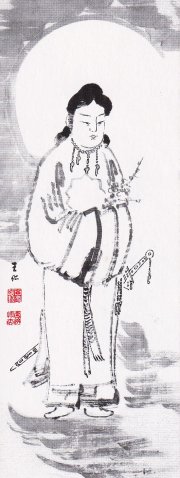 |
|
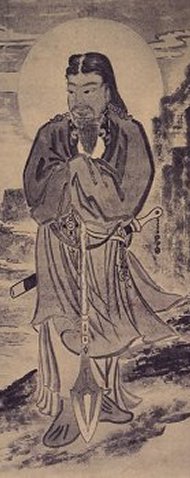 |
Right: Kamususanowo is a manifestation of the Tenso (Progenitor of Heaven), or the Creator of the whole universe and its great spirit world. He is also a saviour kami and the true protagonist in the Reikai Monogatari (Tales of the Spirit World)
Left: Kunitokotachi no Mikoto is the Kokuso (Progenitor of the Earth), or the creator of the Earth and its spirit world. |
The following is a brief overview of Onisaburo Deguchi, his religious group, teachings and other related topics, based on his Reikai Monogatari (Tales of the Spirit World) - the most important holy text for his adherents, which he also terms as the "Book of the Last Judgment."
For details, see About the Reikai Monogatari (Aizen-en)
Please note that some information posted on this site may run counter to popular beliefs about this spiritual crusader and his group named Omoto (Great Origin or Original Root) because those beliefs have not taken the Reikai Monogatari into full account.
Brief Overview
- The Ancient Divine Oath
- The Ichi Rei Shi Kon (One Spirit, Four Souls)
- Omoto Was Founded on February 9, Meiji 31 (1898), Not Meiji 25 (1892)
- Omoto Has Two Founders: Nao Deguchi, and Onisaburo Deguchi
- Onisaburo's Ultimate Sacred Text: The Reikai Monogatari
- Onisaburo Teaches the Transmigration of Souls
- Type of Theim: Monotheism, Polytheism and Pantheism All in One
- Three Irreducible Elements: Rei (Spirit), Ryoku (Power), and Tai (Body, Matter)
- The Maxim Formulated by Onisaburo
1. The Ancient Divine Oath
The divine oath as described in Volume 4 of the Reikai Monogatari pledges that Kamususanowo (a manifestation of the Three Most August Deities, or the Creator of the whole universe) will assist Kunitokotachi (creator of the Earth and its spirit world) in his divine work.
It is in line with this oath that the divine theatrical troupe named Omoto (Great Origin or Great Root) came into being as Kunitokotachi served out his "imprisonment" on Meiji 25 (1892). Onisaburo mainly played the role of Kamususanowo while Nao the role of Kunitokotachi. This is why Omoto needed two charismatic founders to achieve its objectives.

Divine Oath (Vol. 4 of the Monogatari)
According to Volume 4 of the Monogatari, Kunitokotachi's rule was so strict that discontented evil deities launched an anti-Kunitokotachi campaign, plunging the world into pandemonium. The Three Most August Kami of Heaven (another name for the Creator) pleaded with Kunitokotachi to make his rule lax and flexible. For all Their attempt, Kunitokotachi, a deity of absolute truth, justice and integrity, would not budge an inch.
Overgrown evil deities drive out good.
With evil deities going out of control, Kunitokotachi agreed to step down as supreme ruler of the Earth's spirit world and retreated to hell and damnation (where he would become ruler of the Court of Yama).
"I'm too stubborn to adapt myself to the trend of the times," Kunitokotachi admitted. "It is my obstinacy that is responsible for the pandemonium the world has been going through. I will go down to hell to redeem my sin."
Kunitokotachi showed his readiness to live in seclusion to shoulder the sins of all the divinities for the sake of world peace.
The Most August Deities replied: "It fills us with unfathomable sorrow to see you express your willingness to resign out of consideration for our predicament. However, if fortune turns in our favor, we pledge to reinstate you as sovereign kami of the world. When that time comes, we will also descend to the Earth and assist you in your divine work." (See image of the Divine Oath above)
2. The Ichi Rei Shi Kon (One Spirit, Four Souls)
As the Creator of the whole universe, the Tenso (Progenitor of Heaven) has distributed a direct portion of Himself called naohi (direct spirit) to individual humans. This naohi is surrounded by four different souls of ara-mitama (a violent or coercive soul), nigi-mitama (a gentle and pacifying soul), sachi-mitama (a soul that brings happiness or blessings), and kushi-mitama (a soul that causes mysterious transformations), as shown below:

Ichirei-shikon and gojoh-no-kairitsu (Excerpts: Reikai no Saikokimitsu by Yasuaki Deguchi. KK Longsellers, 1999.)
|
Every human has this naohi spirit (direct portion of the Kami) in themselves. This is why Onisaburo says that each person is a "living shrine of the Kami."
For details, see Man as a Living Shrine of Kami
Vol. 6 of the Reikai Monogatari describes Kamususanowo's four souls as follows:
| Soul Type |
Kami in Vol. 6 |
Subsequent Reincarnation |
| His ara-mitama (violent soul) |
Oh Daru-hiko |
Bodhidharma |
| His nigi-mitaka (gentle soul) |
Oh Yashima-hiko |
Buddha |
| His sachi-mitama (happy soul) |
Sukuna-hiko |
Jesus |
| His kushi-mitama (wondrous soul) |
Kamikuni-wake |
Confucius |
Herein lies the basis of Onisaburo's shokyoh-dohkon, the notion of Shinto (not State Shinto), Buddhism, Christianity and Confucianism sharing the same roots.
Todays, a myriad faiths in the world are often based on teachings from Shinto, Buddhism, Christianity and Confucianism, hence bankyoh dohkon (the oneness of all good religions).
Some people have pointed out a number of similarities between Shinto and Judaism. Onisaburo also says that the best of Israel's twelve tribes came to Japan. If this were true, the Japanese imperial family could be descendants of those lost Israeli tribes.
For details, see Onisaburo on Jewish People
3. Omoto Was Founded on February 9, Meiji 31 (1898), Not Meiji 25 (1892)
Volumes 1, 12, 14 and 55 of the Monogatari specify this date, as shown below:
The above is an excerpt from Volume 1 of the Monogatari. It says that Omoto was founded on February 9, Meiji 31 (1898), when Onisaburo had a weeklong initiatory experience on Mount Takakuma.
Twenty-four years had passed since Omoto was founded according to this volume, which was dictated in Taisho 10 (1921). Taisho 10 (1921) - 24 years = Meiji 31 (1898) because Meiji 45 (1912) and Taisho 1 (1912) are the same and should be counted together.
Some argue that Omoto was founded in Meiji 25 (1892), when Ushitora no Konjin (Kunitokotachi no Mikoto) possessed Nao Deguchi and made that famous declaration through her mouth ("The Greater World shall burst into bloom as plum blossoms at winter's end. Ushitora no Konjin has come to reign at last.").
Why Onisaburo had to discreetly deny Meiji 25 and indicate Meiji 31 as the true founding year of Omoto is that its senior members in those days regarded Foundress Nao as inviolable and treated Onisaburo as inferior to her.
But Nao was actually like John the Baptist, who came before Jesus and cried in the wilderness. She set the stage for Onisaburo. Do you think that John founded Christianity? Could be, but it is more natural to think that Jesus initiated the Christian faith.
Just because Nao began conveying divine messages does not mean that she founded Omoto. Though she is loosely called Kaiso-sama (Foundress) today, the true and complete founder is Onisaburo, and that Omoto's foundation is rooted in his initiatory experience on Mount Takakuma on February 9, Meiji 31 (1898).
- Nao: The forerunner, who played a partial role in founding Omoto, and
- Onisaburo: The consummator, who perfected and finalized the founding of Omoto
Incidentally, some say that Nao made that famous declaration on January 5 by the lunar calendar, but Mr. Yasuaki Deguchi asserts through his research that it is actually January 10 by the lunar calendar.
For free PDF downloads of the Monogatari, check the Aizen-en's website.
4. Omoto Has Two Founders: Nao Deguchi, and Onisaburo Deguchi
As mentioned in 3. Omoto Was Founded on February 9, Meiji 31 (1898), Not Meiji 25 (1892), Foundress Nao is the partial founder while Onisaburo is the ultimate founder of Omoto:
- Nao: The forerunner, who played a partial role in founding Omoto, and
- Onisaburo: The consummator, who perfected and finalized the founding of Omoto
Omoto, a divine theatrical troupe, needed two founders to fulfill and act out the Divine Oath, which as described in Volume 4 of the Reikai Monogatari, pledges that Kamususanowo (a manifestation of the Three Most August Deities, or the Creator of the whole universe) will assist Kunitokotachi (creator of the Earth and its spirit world) in his divine work.
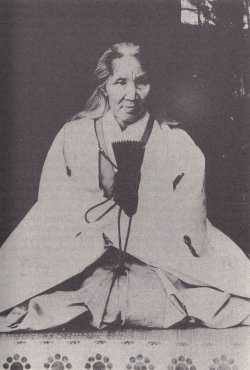 Foundress Nao Deguchi
5. Onisaburo's Ultimate Sacred Text: The Reikai Monogatari
The Reikai Monogatari (Tales of the Spirit World) is a saga of deities in the three major spiritual realms - namely, the shinkai (realm of divinities, or Heaven), the genkai (realm of the material world) and the yukai (realm of stray spirits, or Hell). It is also an odyssey of how good deities will create a Maitreyan utopia on earth while guiding evil spirits back on the right path with divine power.
The Aizen-en describes the Reikai Monogatari as follows:
Of all the writings by Onisaburo Deguchi, the one of the utmost importance is the Reikai Monogatari (Tales of the Spirit World), or the Monogatari for short. It consists of a total of 81 volumes (83 books), which Onisaburo created using the method of dictation. In fact, he dictated to his scribes at the average speed of a whopping 3 days per 300-page volume!
This scripture covers a broad range of topics including the deities of the world, the afterlife, the way of man, prophetic messages and essays on art. It also takes on the aspects of fairy tales as Onisaburo says he wrote it so that even three-year-olds could understand.
Some believers count the Omoto Shin'yu (Divine Revelation of Omoto) as another Omoto scripture. That is understandable because it is Onisaburo's edited and reformulated version of illiterate Foundress Nao's Ofudesaki (Tip of the Writing Brush) automatic writings. For all Onisaburo's editing, the original Ofudesaki writitings pose an existential threat to, hence a serious concern about, the credibility of the Omoto Shin'yu in light of Volume 7 of the Monogatari.
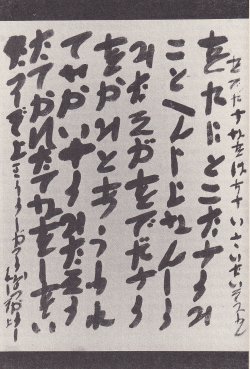 Nao's Ofudesaki
Volume 7 says that Nao remained unaware of the truth about Onisaburo's divinity until September 8, Taisho 5 (1916) - the state which is termed the miken shinjitsu (state of not seeing the truth yet). It goes on to say that Nao was in the miken shinjitsu state for around 25 years, whereas Onisaburo was in the ken shinjitsu (state of seeing the truth) realm 18 years earlier than Nao.
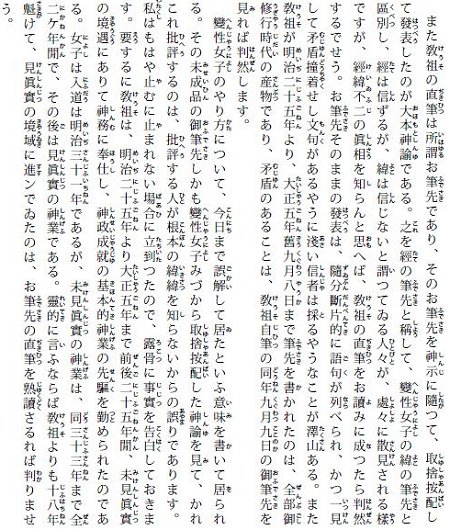 An excerpt from Volume 7 where Onisaburo tells the truth that Nao was in the miken shinjitsu state for around 25 years
The Omoto Shin'yu is based on Nao's writings when she was still in this benighted state and therefore should be discouraged from heavy reliance as a guiding principle because the world of gods is often incomprehensible to us mortals.
The Shin'yu, however, has acquired a new life in Volume 60 of the Monogatari as it features an eclectic collection of Shin'yu passages, as seen below:
 An Omoto Shin'yu passage incorporated in Volume 60 of the Monogatari
6. Onisaburo Teaches the Transmigration of Souls
Onisaburo provides profound insights into how the Spirit World works through his sacred texts and writings, such as the Reikai Monogatari (Tales of the Spirit World) and the Tama no Ishizue (Foundations of the Spirit).
For more information, see How the Spirit World Works
Onisaburo's literature indicates that humans go through different incarnations to achieve spiritual growth during their earthly sojourns and win admission to Heaven upon their return to the Spirit World.
The Foundations of the Soul also says:
Souls are immortal. But when they are reincarnated in the material world, they are under such physical pressure that they lose their past-life memories. This is good in that it will benefit no one to remember their past lives, and that such memories will adversely affect people's current lifetimes.
Meanwhile, when souls return to Heaven, their past memories, wills and thoughts will become all the clearer as they approach it. That is why the return to Heaven is not termed "being reincarnated" but "being resurrected."
According to the Foundations of the Soul, one of the reasons why humans are born into the physical world is that they are tasked with training or enhancing their own spirituality so that they can help Heaven thrive and prosper forever once they are resurrected in the Spirit World.
Volume 56 of the Reikai Monogatari provides the following illustrations of the Spirit World:

- The World of Heaven is composed of the Heavenly Kingdom and the Spiritual Kingdom.
The World of Hell is composed of the Ne no Kuni (Land of the Roots) and the Soko no Kuni (Land of the Bottom).
- The World of Heaven, where the Gods of the Sun and Moon dwell
- The innermost first and highest level of the World of Heaven
- The intermediate second level of the World of Heaven
- The lowest third level of the World of Heaven
- The Intermediate World
- The Intermediate World is also called the World of Stray Souls.
The state of the real world is virtually like a carbon copy of this Intermediate World.
- The World of Hell, where the Devil and Satan dwell
- The first and highest level of the World of Hell
- The intermediate second level of the World of Hell
- The lowest third level of the World of Hell

- Various groups in the Taka-ama-hara (Plain of High Heaven) of the World of Heaven; they are countless in size and number.
- The Spiritual Kingdom (the Kingdom of the Moon)
- Faith
- Truth
- Center
- The Lord Kami (Creator of the Universe) appears as the God of the Moon.
- The first and highest level
- The second highest level
- The third highest level
- The Heavenly Kingdom (the Kingdom of the Sun)
- Love
- Goodness
- Center
- The Lord Kami (Creator of the Universe) appears as the God of the Sun.
- The first and highest level
- The second highest level
- The third highest level
- The World of Hell filled with falsehood and evil desire
- The Ne no Kuni (Land of the Roots)
- Falsehood
- Center
- The Devil
- The Soko no Kuni (Land of the Bottom)
- Evil desire
- Center
- Satan
Volume 56 also points out one of the widespread misunderstandings about the way the Kami (or God, the Almighty, the Lord, etc.) treats people filled with falsehood or evil desire. In other words, the Kami never turns His back on such people, rejects them, punishes them or throws them into Hell. That is because He is intrinsically goodness and love per se, and because if He discriminated against such people, it would contradict His nature and threaten His divinity. It is indeed true that some of such people end up in Hell, but they choose to be there by their own free will as they are dominated by falsehood or evil desire within themselves.
The Kami is like a carp breeder. Imagine that this breeder tries to farm 10,000 young fry and looks forward to the healthy growth of all of them. He would be greatly disappointed if some of them did not grow healthy, others died, or still others were stolen by theives. The breeder's disappointment is often based on material or pecuniary loss, but the Kami's disappointment is based on love, hope and other qualities that go far beyond wordly desires.
For this reason, humans need to constantly trust the Kami, love Him, and do good deeds so that they can return to Heaven and report to the Kami about their spiritual growth and development. Otherwise they would choose to fall into Hell, the most abominable place in the eyes of the Kami.
7. Type of Theim: Monotheism, Polytheism and Pantheism All in One
Onisaburo says that the universe (Creator) shapes like a human being. It has a head, body, heart, lungs, arms, legs, bones, muscles, skin and internal organs, with each made up of living, active cells. He goes on to say that a human being is a minature version of this universe, hence a microcosm.
For details, see The Divine Revelations on the Cosmos (Volume 4 of the Monogatari)
In this respect, there is ultimately One Kami (monotheism), as represented by the whole human being. His portions appear in many different forms such as mankind and animals (polytheism), as represented by the head, body, arms, etc., and plants and inanimate objects (pantheism), as represented by the cells, blood, lymph nodes, etc.
Every being on earth has a portion of the Creator, as shown in The Ichi Rei Shi Kon (One Spirit, Four Souls), with the naohi spirit being a direct portion of the Creator.
Please note, however, that animate beings (humans, animals, etc.) and inanimate objects (minerals, plants, etc.) have different soul types:
- Animate beings: Sei-rei (sophisticated spirit), and
- Inanimate objects: Rei (spirit)
The state of rei varies among creatures; it is latent in minerals, dormant in plants, and active in animals. If what is supposed to be the latent or dormant rei of minerals or plants becomes so active as to respond to people, they will often be the object of worship as holy rocks or sacred trees.
For details, see Rei (spirit) and Sei-rei (sophisticated spirit)
As for the Reikai Monogatari, many deities in the sacred text are manifestations of the Creator, and they all converge back into the Ultimate One. How these kami manifest themselves depends on their specific purposes or missions. This is like the folder hierarchy of a web server. When you open the "root" directory, it shows all the subfolders within, and when you close it, all the subfolders are embraced in the root directory.
As mentioned above, Onisaburo advocates the idea of monotheism, polytheism and pantheism all in one.
8. Three Irreducible Elements: Rei (Spirit), Ryoku (Power), and Tai (Body, Matter)
A young Onisaburo prayed to his tutelary kami at Obata Shrine in Anao, Kyoto night after night, and on the 21st night, he received the following revelation:
- Observe the true phenomena of heaven and earth, and you will see the substance of the true Kami.
- Recognize the unerring functioning of all things, and you will see the energy of the true Kami.
- Penetrate into the essential nature of living beings, and you will see the spirit of the true Kami.
For detailed description, see Three Verities (on the Aizen-en's website)
Mr. Yasuaki Deguchi also describes how Kisaburo Ueda (Onisaburo's original name) received the divine revelation in his book titled Mother Earth. It is a novelistic biography of Onisaburo Deguchi.
For the actual narrative depiction, read Mother Earth, Volume 2: The Secrets of the Sacred Mountain, Chapter 5: Three Verities (on the Aizen-en's website)
Onisaburo says that when spirit and matter unite, it produces a synergetic power.
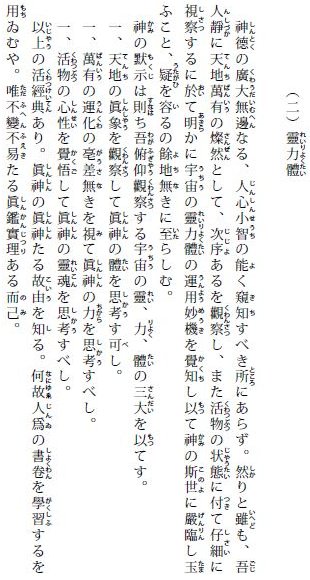 Three major principles of rei (spirit), ryoku (power), and tai (body, matter) (An excerpt from Volume 13 of the Reikai Monogatari)
9. The Maxim Formulated by Onisaburo
The Kami is the all-pervading Spirit of the Universe, and man is the nucleus of the workings of heaven and earth. When the Kami and man unite, infinite power and authority will become manifest.
The above suggests that some creative synergy will unfold when the Kami and man become one.
 A variant of the Maxim as mentioned in Volume 67 of the Monogatari
For detailed description, see the Maxim (on the Aizen-en's website)

| Brief Overview |
| Group names: | Omoto, Kodo Omoto, Aizen-en, and others
(Note)
The group often changed its name for a particular purpose in a particular period of its history. |
| Founded on: | Feb. 9, Meiji 31 (1898)
(Note)
Vols. 1, 12, 14 and 55 of the Monogatari specify this date. Some argue that Omoto was founded in Meiji 25 (1892), when Ushitora no Konjin (Kunitokotachi no Mikoto) possessed Nao Deguchi and made the famous declaration through her mouth ("The Greater World shall burst into bloom as plum blossoms at winter's end. Ushitora no Konjin has come to reign at last.").
But Nao was like John the Baptist, who came before Jesus. She prepared things for Onisaburo. Do you think John founded Christianity? Could be, but it is more natural to think it began with Jesus. Just because Nao began conveying divine messages does not mean she founded Omoto. Though she is loosely called Kaiso-sama (Foundress) today, the webmaster thinks the true founder is Onisaburo and Omoto's foundation is rooted in his initiatory experience on Mount Takakuma on Feb. 9, Meiji 31 (1898).
Incidentally, some say Nao made the declaration on Jan. 5, but Mr. Yasuaki Deguchi's research shows it is actually Jan. 10.
For free PDF downloads of the Monogatari, check out this webpage from the Aizen-en.
|
| Founded by: | Onisaburo Deguchi
(Note)
For the reason cited in the previous field, the webmaster would say the true founder is Onisaburo. Nao played a great role in heralding the faith, but she was more of a forerunner.
See Onisaburo in motion (The Aizen-en)
Incidentally, Onisaburo's Esperanto name is Onisavulo. Oni in Onisaburo means "people," sav means "to save," and ulo means "the one." Altogether, it stands for the "one to save people" = "saviour." |
| Scripture: | The Reikai Monogatari
(Note)
Some count The Omoto Shinyu as another Omoto scripture. It is true in a way, but it also has some alarming factors in light of Vol. 7 of the Monogatari. This volume says Nao did not see the truth about Onisaburo's divinity until Sep. 8, Taisho 5 (1916) - this state is called miken shinjitsu ("state of not seeing the truth"). Based on Nao's writings when she was still in this benighted state, the Omoto Shinyu should be discouraged from being heavily relied on as a guiding principle.
Good news for the Shinyu readers. The Shinyu has a new life in the Monogatari as its selected portions are included in Vol. 60.
For free PDF downloads of the Monogatari, check out this webpage from the Aizen-en.
|
| Chief deity worshipped: | Kamususanowo no Okami
(Note)
This deity (Creator) is revered under different names in different faiths, such as God, Allah, and Heavenly Suzrain, but all refer to the Ultimate Cause of the universe. As in Vol. 47 of the Monogatari, Onisaburo chooses this name for the Creator based on kototama, a belief that a sacred power or spirit dwells in the words of the traditional Japanese language.
Onisaburo says a soul of a deity or a human can be divided into four portions depending on the soul's activity: nigi-mitama, ara-mitama, kushi-mitama, and sachi-mitama. The four soul aspects for Kamususanowo are Buddha (nigi-mitama), Bodhidharma (ara-mitama), Confucius (kushi-mitama), and Jesus (sachi-mitama). Citing this, Onisaburo says Shinto (not State Shinto), Buddhism, Confucianism and Christianity share the same roots (See Vol. 6 of the Monogatari).
To remind you just in case, the webmaster is not saying all other deities but Kamususanowo are negligible. They are important too, but Kamususanowo is the most important. In fact, Onisaburo says when you pray, pray to the Creator.
For free PDF downloads of the Monogatari, check out this webpage from the Aizen-en.
|
| Holy land: | Taniha (Tamba) region of Kyoto, including Kameoka and Ayabe |
| Creator of the universe: | Kamususanowo no Okami = Tenso (The Universe-Eternally-Standing-Deity)
(Note)
The Omoto literature including the Monogatari often mentions Tenso (Creator of the universe) and Kokuso (Creator of Planet Earth). Tenso is usually identified as Kamususanowo. |
| Creator of Planet Earth: | Kunitokotachi no Mikoto = Kokuso (The Earth-Eternally-Standing-Deity)
(Note)
The Omoto literature including the Monogatari often mensions Tenso (Creator of the universe) and Kokuso (Creator of Planet Earth). Kokuso is usually identified as Kunitokotachi no Mikoto, ruler of the divine world of Planet Earth.
Also, Vol. 4 (The Shinji no Uchu) says Kunikototachi is the creator of the spirit world of a small cosmos including heavenly bodies in our solar system. 5.67 billion such small cosmoses constitute the Greater Cosmos ruled by Tenso (The Universe-Eternally-Standing-Deity). (The number 5.67 billion would be better off taken figuratively.)
For free PDF downloads of the Monogatari, check out this webpage from the Aizen-en.
|
| Divine oath: | Tenso (Kamususanowo) will descend to earth to help restore the reign of Kokuso (Kunitokotachi)
(Note)
In the age of the divinities, Kunitokotachi ruled the divine world of Planet Earth. But evil-minded deities made every effort to thawt his reign, and they eventually entrapped him into stepping down (See Vol. 4). When Kunitokotachi resigned, Tenso came down to earth and promised that when the time was ripe, Tenso would descend to earth to help reinstate Kunitokotachi as supreme ruler. The birth of Omoto is partly based on this oath.
For free PDF downloads of the Monogatari, check out this webpage from the Aizen-en.
|
| Type of theim: | Monotheism, polytheism and pantheism in one.
(Note)
Onisaburo says many deities (as seen in the Monogatari) are manifestations of the Creator, and they all converge back into the Creator. (How they manifest themselves depends on their specific purposes or missions.) It is like the folder hierarchy of a web server; when you open the "root" directory, it shows all other subordinate folders within the root, and when you close, the folders return to the root. (See Onisaburo's View on Divinity)
|
| Three irreducible elements: | Rei (spirit), ryoku (power), and tai (body, matter)
(Note)
Onisaburo says when spirit and matter unite, it produces a synergetic power. (See The Three Rules of Learning) |
|
